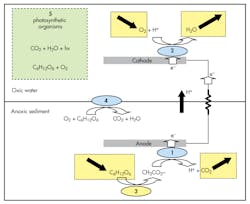Engineers at the U.S. Naval Research Laboratory’s Center for Biomolecular Science and Engineering recently patented a self-assembling, self-repairing, and self-contained microbial photoelectrochemical solar cell driven entirely by sunlight and microorganisms. The solar microbial fuel cell (SMFC) is a non-semiconductor-based device which uses microorganisms to generate electric power by photosynthetically replenishing reactants using sunlight.
The SMFC reactants (glucose and oxygen) are regenerated inside the cell by a group of photosynthetic microbes whose reactants, carbon dioxide (CO2) and water (H2O), are produced in the fuel cell. This interdependency lets the device generate electricity for many thousands of hours needing the reactants replaced.
“Natural photosynthetic systems, such as trees and algae blooms, self-repair—a property that makes them highly durable,” says Lenny Tender, research chemist at the Center. “For this device, we incorporate photosynthetic organisms into the self-assembling and self-maintaining fuel cell to make durable land-based photoelectrochemical solar cells.
“Microorganisms harvested from sea water in shallow coastal environments, in relatively low abundance, are enriched when the cell is sealed due to accumulation of carbon dioxide and depletion of oxygen,” Tender continues. “These organisms use sunlight to convert the electrode products to glucose and oxygen, which can be re-used in the electrode reactions, eliminating the need for a constant flux of new glucose and oxygen.”
Tender says the SMFC also combines energy storage with power delivery. So when there is plenty of sunlight, photosynthesis leads to production of fuel and oxidant. Some of this is used to generate power immediately, with the remainder stored to be used later when there is no sunlight. This will ideally done without the need for capacitors or batteries.
The SMFC can be “stacked” in series to increase voltage and can power any device that currently uses a conventional photovoltaic power supply. However, work is underway to understand limiting factors.


